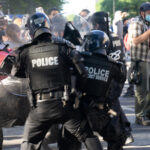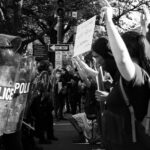There are pervasive negative impacts on the physical, social, emotional, and mental well-being of those exposed to the various forms of police violence (APHA, 2018).
Physical Health Impacts
One of the clearest pathways that police violence harms health is through direct physical injury and premature death. In the United States, police violence has become a leading cause of death for young men (Edwards et al., 2019). Black and American Indian/Alaska Native men have an even higher risk of being killed by the police in their lifetime compared to their white counterparts (APHA, 2018). For instance, Black men have over twice the odds of being killed by the police over their life course compared to their white counterparts. (Edwards et al., 2019). Research from 2016 found that although violent crime rates have been decreasing since the 1990s, the full scope of mortality and morbidity related to physical violence from law enforcement is unknown due to limited data collection by the Centers for Disease Control and Prevention and lack of data transparency from law enforcement agencies (APHA, 2018).
Mental Health Impacts
Though there are clear physical impacts related to morbidity and mortality, police violence can cause harm even without direct injury (Boyd, 2018). Adverse health outcomes of police violence include symptoms of trauma, anxiety, depression, and posttraumatic stress disorder. Individuals who have experienced police violence they perceived as discriminatory suffer a greater risk for mental health symptoms such as anxiety, depression, and post-traumatic stress disorder (Alang et al., 2017; APHA, 2018). A study evaluating suicide attempts among victims of police violence in the United States found a 12-month increased prevalence of suicide attempts among adults exposed to physical or sexual police violence compared to those who had not been exposed to physical or sexual police violence (DeVylder et al., 2017). People experience psychological stress when exposed to a threat causes their bodies to produce stress hormones and other physiological changes, such as accelerated heart rate and increased respiratory rate (Alang et al., 2017). The psychological stress that comes from repeated exposure to police violence can cause an extended stress response, sometimes called toxic stress, leading to wear and tear on the body and chronic conditions such as stroke, diabetes, obesity, ulcers, cognitive impairment, and early mortality (Alang et al., 2017; APHA, 2018).
Health Inequities
With both physical and mental health impacts, significant inequities along racial lines exist regarding who experiences excessive police violence and its corresponding health impacts.
- For instance, a study from 2017 found that Black and Native American people were three and six times more likely than the general population to be admitted to emergency rooms for injuries sustained during an encounter with law enforcement (Miller et al., 2017).
- Additionally, Black people are five times more likely to be shot by police compared to White people (Bowleg et al., 2020).
- Women, especially women of color, are also disproportionately impacted by sexual violence perpetrated by law enforcement (APHA, 2018). A study in 2003 found that of the women in New York City, 38% of Black women, 39% of Latinas, and 13% of Asian or Pacific Islander women reported experiencing sexual harassment perpetrated by police officers (Fine et al., 2003). Sexual violence has physical, emotional, and mental health consequences for those victimized (CDC, 2016).
Community Impacts
Individuals and whole communities suffer psychological stress related to living in neighborhoods with high rates of police use-of-force and stop-and-frisk practices (APHA, 2018; Cooper, 2015). Extended toxic stress response and subsequent health consequences can be activated in individual victims and even among community members that are not directly victimized by police violence, including pregnant people and their unborn infants. A recent study in California found being exposed to fatal police violence events in their census tract during pregnancy was associated with a small increased hazard of late preterm birth (Goin et al., 2021). Additionally, the research found a significant association “between antenatal depression in pregnant African American women and anticipated negative encounters between African American youth and police” (Jackson et al., 2017).
Witnessing police brutality and violence that goes unpunished sends a message to Black communities that their bodies are disposable and do not deserve dignity or justice (Alang et al., 2017). The general population shares the trauma of witnessing police violence. The mass media coverage of police violence, specifically fatal incidents of police violence, spreads the mental health impacts beyond those in the local neighborhood to Black people in the general population (Bor et al., 2018), including children. Adolescents that view race-related traumatic events online, including police violence, have an increased risk for depressive and PTSD symptoms (Tynes et al., 2019).
Witnessing police violence can also cause people to be concerned about potential negative encounters with the police (DeVylder et al., 2020). Research has found that among Black men, avoidance of the police due to fear of undue violence increases the severity of depressive symptoms (Bowleg et al., 2020). Naturally, fear of violence can cause stress. Parents of children of color also face the stress of their children encountering these negative interactions. A 2014 study found that police officers overestimated the age of Black and Latino child suspects of crimes but not white child suspects (Goff et al., 2014). The same study found that Black male children specifically were viewed as older and less innocent and were more likely to face police violence if accused of a crime than their white counterparts (Goff et al., 2014). Many parents of Black children must have “the talk” with their children at very young ages to explain how to survive an encounter with the police (Whitaker & Snell, 2016). This conversation is about the potential of being perceived as criminal for innocuous behaviors like sitting in a Starbucks or going for a walk and how to diffuse negative perceptions and stereotypes to avoid being killed by the police (Whitaker & Snell, 2016; McNamarah, 2019). These parental fears are warranted, given how Black people regularly have the police called on them for innocuous behaviors (McNamarah, 2019). In addition to causing racialized trauma and post-traumatic stress disorder, these encounters can be deadly for Black children (McNamarah, 2019).
- Alang, S., McAlpine, D., McCreedy, E., & Hardeman, R. (2017). Police Brutality and Black Health: Setting the Agenda for Public Health Scholars. American Journal of Public Health, 107(5), 662–665. https://doi.org/10.2105/AJPH.2017.303691
- American Public Health Association. (2018). Addressing Law Enforcement Violence as a Public Health Issue [Policy Report]. https://www.apha.org/policies-and-advocacy/public-health-policy-statements/policy-database/2019/01/29/law-enforcement-violence
- Bor, J., Venkataramani, A. S., Williams, D. R., & Tsai, A. C. (2018). Police killings and their spillover effects on the mental health of black Americans: A population-based, quasi-experimental study. The Lancet, 392(10144), 302–310. https://doi.org/10.1016/S0140-6736(18)31130-9
- Bowleg, L., Maria del Río-González, A., Mbaba, M., Boone, C. A., & Holt, S. L. (2020). Negative Police Encounters and Police Avoidance as Pathways to Depressive Symptoms Among US Black Men, 2015–2016. American Journal of Public Health, 110 (Suppl 1), S160–S166. https://doi.org/10.2105/AJPH.2019.305460
- Boyd, R. W. (2018). Police violence and the built harm of structural racism. The Lancet, 392(10144), 258–259. https://doi.org/10.1016/S0140-6736(18)31374-6.
- Centers for Disease Control and Prevention, Division of Violence Prevention, National Center for Injury Prevention and Control. (2016). Preventing Multiple Forms of Violence: A Strategic Vision for Connecting the Dots. 18.
- Cooper, H. L. (2015). War on Drugs Policing and Police Brutality. Substance Use & Misuse, 50(8–9), 1188–1194. https://doi.org/10.3109/10826084.2015.1007669
- DeVylder, J. E., Frey, J. J., Cogburn, C. D., Wilcox, H. C., Sharpe, T. L., Oh, H. Y., Nam, B., & Link, B. G. (2017). Elevated Prevalence of Suicide Attempts among Victims of Police Violence in the USA. Journal of Urban Health : Bulletin of the New York Academy of Medicine, 94(5), 629–636. https://doi.org/10.1007/s11524-017-0160-3
- DeVylder J, Fedina L, Link B. (2020) Impact of Police Violence on Mental Health: A Theoretical Framework. American Journal of Public Health 110(11): 1704-1710. https://doi.org/10.2105/AJPH.2020.305874
- Edwards, F., Lee, H., & Esposito, M. (2019). Risk of being killed by police use of force in the United States by age, race–ethnicity, and sex. Proceedings of the National Academy of Sciences, 116(34), 16793-16798. https://doi.org/10.1073/pnas.1821204116
- Fine et al., 2003 “Anything Can Happen With Police Around”: Urban Youth Evaluate Strategies of Surveillance in Public Places. J of Social Issues 59(1):141-158. https://doi.org/10.1111/1540-4560.t01-1-00009
- Goff et al. (2014) The essence of innocence: Consequences of dehumanizing Black children. Journal of Personality and Social Psychology 106(4), 526–545. https://doi.org/10.1037/a0035663
- Goin et al. (2021) Maternal experience of multiple hardships and fetal growth: Extending environmental mixtures methodology to social exposures. Epidemiology. 2021 Jan; 32(1): 18–26. doi: 10.1097/EDE.0000000000001272
- Jackson et al., 2017 Anticipated Negative Police-Youth Encounters and Depressive Symptoms among Pregnant African American Women: A Brief Report. Journal of Urban Health 94: 259–265. https://doi.org/10.1007/s11524-017-0136-3
- McNamarah, CT. (2018-2019) White Caller Crime: Racialized Police Communication and Existing While Black 24 Mich. J. Race & L. 335 (2018-2019). https://heinonline.org/HOL/P?h=hein.journals/mjrl24&i=347
- Miller et al., 2017 Perils of police action: a cautionary tale from US data sets. Injury Prevention 23(1). http://dx.doi.org/10.1136/injuryprev-2016-042023
- Tynes et al. (2019) Race-Related Traumatic Events Online and Mental Health Among Adolescents of Color. Journal of Adolescent Health 65(3):371-377 https://doi.org/10.1016/j.jadohealth.2019.03.006
- Whitaker TR, Snell, CL. (2016) Parenting while powerless: Consequences of “the talk” Journal of Human Behavior in the Social Environment 26(3-4):303-309 https://doi.org/10.1080/10911359.2015.1127736



